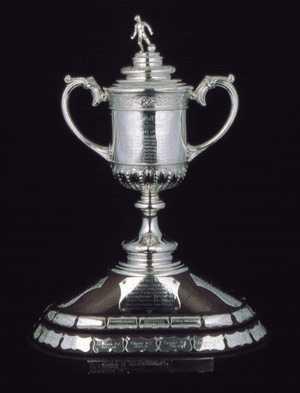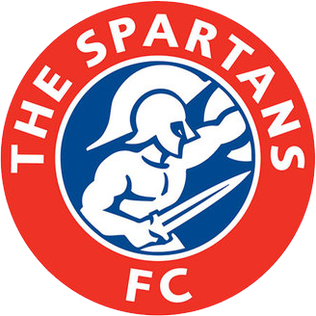
The Scottish Highland Football League is a senior football league based in the north of Scotland. The league sits at level 5 on the Scottish football league system, acting as a feeder to the Scottish Professional Football League.

The East of Scotland Football League (EoSFL) is a senior football league based in the east and south-east of Scotland. The league sits at levels 6–9 on the Scottish football league system, acting as a feeder to the Lowland Football League.
The Scottish football league system is a series of generally connected leagues for Scottish football clubs.

The Scottish Football Association Challenge Cup, commonly known as the Scottish Cup, is an annual association football knock-out cup competition for men's football clubs in Scotland. The competition was first held in 1873–74. Entry is open to all 122 clubs with full membership of the Scottish Football Association (SFA), along with up to eight other clubs who are associate members. The competition is called Scottish Gas Men's Scottish Cup for sponsorship reasons.
The Scottish Professional Football League Challenge Cup, commonly known as the Scottish League Challenge Cup or Scottish Challenge Cup, and currently known as the SPFL Trust Trophy for sponsorship reasons, is an association football knock-out cup competition run by the Scottish Professional Football League (SPFL). It is recognised as the third most prestigious knockout trophy in Scottish football, after the Scottish Cup and the Scottish League Cup.

The Scottish League Cup is a football competition open to all Scottish Professional Football League (SPFL) clubs. First held in 1946–47, it is the oldest national League cup in existence. The competition had a straight knockout format but became a group and knockout competition from 2016–17.

The Spartans Football Club are a Scottish football club based in Edinburgh. They were formed in 1951 by ex-players of Edinburgh University and the original intention was the team would be exclusively graduates of the university. However, the club is now open to players of any background. Spartans play at Ainslie Park and wear white shirts, red shorts and white socks.

Kelty Hearts Football Club is a football club based in the village of Kelty in Fife, Scotland. Formed in 1975 and nicknamed the Hearts, the Maroon Machine and the Jambos, they play their home games at New Central Park. Their home colours are maroon shirts, white shorts and maroon socks, while their away colours are typically all blue.

Scotland was one of the earliest modern footballing nations, with Glasgow club Queen's Park early pioneers of the game throughout the UK. More clubs formed in Scotland, resulting in the commencement of the first major competition in 1873, the Scottish Cup, then the founding of the Scottish Football League in 1890. With the official sanctioning of professionalism, the Old Firm of Celtic and Rangers became dominant in Scotland, and remain so, although other clubs have enjoyed brief periods of success too.
The Scottish Lowland Football League and the Park’s Motor Group Scottish Lowland League for sponsorship reasons is a senior football league based in central and southern Scotland. The league sits at level 5 on the Scottish football league system, acting as a feeder to the Scottish Professional Football League, and is above three regional leagues at level 6.

The Scottish Professional Football League (SPFL) is the national men's association football league in Scotland. The league was formed in June 2013 following a merger between the Scottish Premier League and the Scottish Football League. As well as operating its league competition, which consists of the top four levels of the Scottish football league system, the SPFL also operates two domestic cup competitions, the Scottish League Cup and the Scottish Challenge Cup. While the Scottish Cup includes all the teams within the SPFL, the competition is run and organised by the Scottish Football Association.

The Scottish Premiership known as the William Hill Premiership for sponsorship reasons, is the top division of the Scottish Professional Football League (SPFL), the league competition for men's professional football clubs in Scotland. The Scottish Premiership was established in July 2013, after the SPFL was formed by a merger of the Scottish Premier League and Scottish Football League. There are 12 teams in this division, with each team playing 38 matches per season. Sixteen clubs have played in the Scottish Premiership since its creation in the 2013–14 season. Celtic are the current league champions, having won the 2023–24 Scottish Premiership.
The 2016–17 Scottish League Cup was the 71st season of Scotland's second-most prestigious football knockout competition.
In addition to their first team competing in the Scottish Premiership, Aberdeen Football Club also maintain further teams for younger age groups playing in competitions such as the Scottish Challenge Cup and the Scottish Youth Cup within the club's academy.

The 2017 Scottish Challenge Cup final, also known as the Irn-Bru Cup final for sponsorship reasons, is a football match that took place on 25 March 2017 at Fir Park, between Dundee United and St Mirren. It was the 26th final of the Scottish Challenge Cup since it was first organised in 1990 to celebrate the centenary of the now defunct Scottish Football League and the fourth since the Scottish Professional Football League was formed. Both teams progressed through four elimination rounds to reach the final. The match was won by Dundee United 2–1, marking their first win in the tournament since its inception and their first silverware since the 2009–10 Scottish Cup.
The 2019–20 Scottish Challenge Cup known as the Tunnock's Caramel Wafer Challenge Cup due to sponsorship reasons, was the 29th season of the competition. The total number of participating clubs is 58. The competition began on 6 August 2019 with the First Round and was due to end on 28 March 2020 with the final at McDiarmid Park in Perth. However, the final had to be postponed due to the COVID-19 pandemic and was never subsequently played.

The West of Scotland Football League (WoSFL) is a senior football league based in the west of Scotland. The league sits at levels 6–10 on the Scottish football league system, acting as a feeder to the Lowland Football League.
The 2022–23 Scottish Lowland Football League was the 10th season of the Lowland Football League, part of the fifth tier of the Scottish football pyramid system. Bonnyrigg Rose Athletic were the reigning champions, but were unable to defend their title following their promotion to Scottish League Two.










